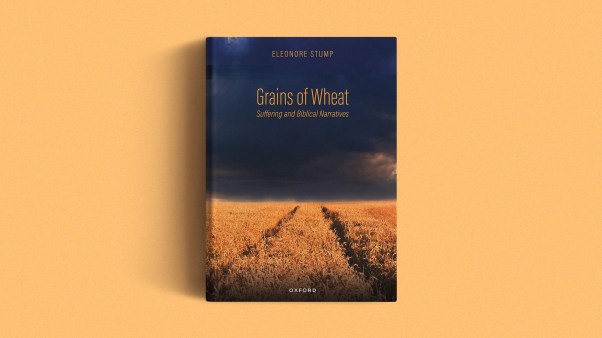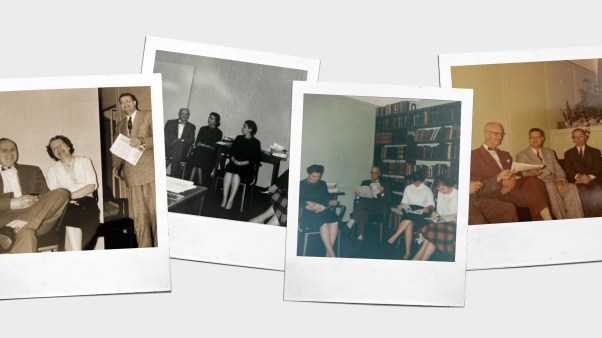Original Sources
A New Eusebius, edited by J. Stevenson, Macmillan, 1957. $4.50.
The best way to study history is, of course, by reading the original sources. In most areas, however, they are so voluminous that time permits very few people to follow that policy. The history of the ancient church is an exception. Here the sources are relatively few, and a reasonable number of them may be read within the average man’s time budget. But are they accessible? The answer is: Yes, increasingly so. One of the newest and best helps to that end is the present volume. Just as the original Eusebius made up a large part of his text by quotation from earlier writers, this is a source book in which are gathered for the reader the most important documents or extracts from them in English translation.
The volume is based on an earlier collection, now out of print, B. J. Kidd: Documents Illustrative of the History of the Church, and covers the period up to 337. It is, however, an improvement upon the already very useful Kidd. It contains more selections (319, of which 266 cover the period of Kidd, v. I as against 225 in the latter). The arrangement of the selections by subject rather than by author’s date is a great advance in usefulness. Explanatory notes are added at the end of a large number of selections. There are very useful annotations on the source documents and their authors, a fine set of chronological tables, an endpaper map and an extensive index. Anyone interested in the ancient church needs to have the volume at hand.
PAUL WOOLLEY
Novel Solution
The Hill of Stoning, by Edward V. Ruskin, Vantage, New York, 1956. $3.50.
Puzzled as all evangelical expositors have been by the dilemma of Jesus’ apparent expectation of an early return to earth and by his apparent failure to do so, the writer of this book attempts a novel and somewhat startling solution. He proposes that the appearance of Jesus to the dying Stephen was the fulfilment of his promised return, and that he was secretly and invisibly present with the Church ever thereafter. He adopts the “year-day” theory of chronology, making the 69 weeks of Daniel 9 equal to the chronological span between the edict of Cyrus to rebuild Jerusalem and the public appearance of the Messiah on Palm Sunday. The seventieth week he interprets as the time between Palm Sunday and the conversion of Cornelius, with the midpoint of the week at Stephen’s martyrdom.
The “he” of Daniel 9:27 he refers to the Messiah, not to the “prince that shall come” of verse 26. The cessation of the sacrifice he equates with the sermon of Stephen, who pointed out that the worship of God did not need either sacrifice or Temple. The “one that maketh desolate” he asserts is Saul of Tarsus, who desolated the Church by persecution.
Along with this revolutionary hypothesis he suggests some other equally unconventional interpretations. The election of Matthias was a mistake which prepared the way for the establishment of a hierarchy in the Church. Stephen was the “beloved disciple” of the Fourth Gospel, and its author. Peter was in error when he wrote that “the Lord is not slack concerning His promise as some count slackness” (2 Pet. 3:9), because he did not recognize the fact that Jesus had already come. His statement, therefore, has misled the entire Christian Church since then, and has obscured the truth which has only recently been made plain to the author of this book. James, the moderator of the Jerusalem church and brother of Jesus, was a Jew at heart rather than a Christian, an enemy of Paul, and a traitor to Christian faith who did nothing to rescue Peter from prison or to avert the arrest of Paul in Jerusalem.
While new light on Scripture is always welcome to its students, Mr. Ruskin’s interpretations will not meet universal approval. Too many of them are unproved and probably unprovable. For instance, while it may be possible that the Fourth Gospel was written—though perhaps not published—in the first decade of the Christian Church, there is no external evidence whatever that it was written by Stephen, and the internal evidence adduced here is quite inconclusive.
Neither in history nor in eschatology does this book make a very convincing case for its contentions. The author fails to explain how Jesus’ predictions of a final judgment could have been fulfilled if his return took place in 35 A.D., nor why the epistles of Paul, written after that, should still predict his future advent. His theory of the tension between Peter and James on the one hand and Stephen and Paul on the other sounds like a counterpart of the Tubingen theory of a century ago. It makes interesting reading, but it cannot be considered as the final interpretation of Christianity in the apostolic age.
MERRILL C. TENNEY
Guide For Study
The Epistle to the Hebrews, by Gleason L. Archer, Jr., Baker, 1957. $1.50.
This is a Bible study handbook of great value. Based on an exhaustive study of the Greek and Hebrew, it presents a summary of the literary questions connected with the epistle, a detailed analysis of the epistle in outline form and then an exposition corresponding to the outline by way of definition, explanation and suggestion.
For a minister preaching through the book of Hebrews this little book will be most suggestive and will take the form of a guide. For a lay student wishing to master the contents of the book of Hebrews, Dr. Archer’s treatise will be most illuminating.
H. J. OCKENGA
“Biblical” Preaching
The Integrity of Preaching, by John Knox, Abingdon, 1957. $1.75.
These days everyone seems to be jumping on the bandwagon of biblical preaching. In this little volume the author, professor at Union Theological Seminary, New York, makes an eloquent plea for the cause. Biblical preaching he recognizes as a pressing need of the day, but he defines it as expounding texts as recurring events in our history and as concerning the great event, Christ. Such preaching, he believes, will be personal, priestly and sacramental.
With many things in the book one is in hearty agreement. There is a pressing need for biblical preaching; there is a need for teaching from the pulpit; there must be careful study of the text and historical circumstances of the passage; and every preacher certainly should immerse himself in his own message before ministering to others.
However, these thrusts of the book in the right direction are largely abrogated by the author’s basic position. To him biblical preaching is not really Bible preaching. In reality the Bible is merely a witness to what we should preach and not the substance which we preach. While the book emphasizes the need for faithful pursuit of the art of exegesis, the impression is left that biblical preaching must not emphasize the historical facts which occurred in the first century. Again, while the author pleads for preaching which concerns what he calls the central event of the Bible, Christ, and although he mentions many of the important events of the life of Christ—even atonement—he fails ever to include preaching about the blood of Christ. Furthermore, the author’s conception of authority in preaching is not based on biblical preaching but on relevant (twentieth century) preaching. Somewhere in the background, one suspects, there has been strong neo-orthodox influence moulding this manuscript.
To those who may read this book: (1) beware of the basic position, and (2) be aware of what is not said as well as what is said.
CHARLES C. RYRIE
Constant In Prayer
The Sure Victory, by Madame Chiang Kai-shek, Revell, 1957. $1.00.
It is important and interesting for us to be informed concerning the religious faith of such a personality as Madame Chiang Kai-shek. This little book (45 pages) is a kind of spiritual autobiography. The author tells of the remarkable faith of her mother and shows how her own faith developed from the early formal, intellectual faith to a genuine heart faith, deepened largely through the experiences of the difficult years of Japanese terrorism and Communist infiltration.
The “sure victory” over the forces of evil in this world is through prayer, the author claims. She describes the way in which her little prayer group has grown and many others have sprung up throughout Formosa. She tells of how much has been accomplished through their efforts, including the supplying of Christian chaplains for the Chinese armed forces. She makes a plea for a chain of prayer groups throughout the world as the means of achieving victory over non-Christian ideologies.
Surely we rejoice at this insistence upon the importance of prayer in the individual Christian life and the power of prayer in world affairs. But the fact that these prayer groups were originated outside the Christian church appears to be a sad commentary upon the condition of the Protestant church in Free China. Is it not because the church has failed to provide an earnest, vital fellowship of prayer and failed to possess an evangelistic zeal that would make it reach out to the lives of those who were in need of the Gospel that Madame Chiang and her friends were compelled to begin prayer groups of their own? And is it not regrettable that the zeal of these prayer groups is not being incorporated into the church as well as strengthened by the doctrinal backbone that the church should be able to offer?
NORMA R. ELLIS
Young Churches
The Church in Southeast Asia, by Rajah B. Manikam and Winburn T. Thomas, Friendship, New York. Cl. $2.50, pap. $1.25.
This book was written under the sponsorship of the Joint Commission on Missionary Education of the National Council of Churches of Christ in the U. S. A. as a mission study book for adults. Leaders of study groups will find this book basic for mission study.
The authors are exceptionally well-equipped for the preparation of this survey. Dr. Manikam, a native of India, has done post-graduate work in the U. S., earning both Ph.D. and B.D. degrees. For 20 years he was an active leader in the National Christian Council of India. From 1950 to 1955 he was joint secretary in East Asia of the World Council of Churches and the International Missionary Council, a position that required travel throughout Southeast Asia and provided an intimate knowledge of the life and work of the Church. Since January, 1956, Dr. Manikam has been Bishop of the Tranquebar of the Federation of Evangelical Lutheran Churches of India.
Dr. Thomas is a native of Arkansas who in 1933 went to Japan as a missionary under the Board of Foreign Missions of the Presbyterian Church in the U.S.A. The years of World War II were spent in the U.S. where he earned his Ph.D. and served with the Student Volunteer Movement. He has traveled extensively in the Far East and since 1951 has been field representative in Indonesia of the National Council of the Churches of Christ in U.S.A., living in Djakarta.
In the compass of this brief volume of 167 pages is packed a mass of information of the Church in every country of this area. An account of the political situation of each country is presented. The culture and religions of these lands are discussed and the Church is seen in her environment, problems, state of health, progress and prospects.
Of special interest is the effect of nationalism and communism both upon the Church and upon work of missions.
Surprising is the strength of the churches. For example, in Indonesia there are thirty autonomous church bodies, numbering 5,000 to 600,000 Christians each. There is a Protestant “community” of about 5,000,000.
The vast numbers of the unreached is overwhelming, nearly 175,000,000, and the density of this population is almost unbelievable. In the delta near Saigon (Indo-China) up to 6,000 rural people are living in each square mile.
The Church in Southeast Asia is chiefly factual and very informative. There are sketches of men and women, whose service to the Kingdom reveals what God can do through lives transformed by his power.
In his portion of the foreword Dr. Manikam says, “These young churches in these old lands of Southeast Asia are minority churches set amidst vast numbers of non-Christians, and they therefore face many problems. But thank God they are there—in every one of these countries—and however small they may be, they are the hope of these countries.… The churches in these ancient lands of Southeast Asia beckon to their partners in North America to come over and help them. May God help many to hear this Macedonian call! This time it comes from Southeast Asia.”
LEWIS H. LANCASTER
Superego Theory
Psychotherapy and Religion, by Henry Guntrip, Harper, 1957. $3.00.
This book by an English clergyman-psychotherapist is more concerned with elaboration and promotion of a theory of neurosis than with finding how Christianity can better collaborate with psychotherapy.
The system presented is an extension of the Melanie Klein variation of Freudian superego theory and was formulated by Fairbairn, a British psychoanalyst. The Freudian concept of instinct is discarded in favor of the viewpoint that all impulses arise from object relationships. The biological context of classical psychoanalysis thus gives way to a social orientation, personal relationships being regarded as paramount. The Freudian ideas of repression and unconscious are retained.
According to this theory, the disturbing figures of childhood are banished by repression deeply into the unconscious, where the ego continues to maintain with them relationships of longing, anger and fear. Anxiety is the product of these repressed bad object relationships. Neurosis is the consequence of the disintegrating, demoralizing influence of this continuing conflict.
Healthy self-realization is achieved, not by the scientific analysis of the individual’s history, but by a therapeutic personal relationship with the therapist. Psychotherapy may not be unscientific, but must be more than merely scientific. Values must be a concern of the therapist, although they lie outside the domain of science. The patient must go beyond the utilitarian goals of symptom relief and economic rehabilitation to face the kind of person he is.
The author struggles with the question of relativity of values, coming to rest in an ambiguous position where values are recognized as essential but are to be judged in terms of mature and successful personality. Man remains the measure.
The closing chapter, with the same title as the book, likewise reflects the author’s ambiguity. His effort to maintain some kind of scientific status as a psychotherapist seems to stand in the way of his offering as a minister any real contribution to improvement of relationships between Christianity and psychotherapy. He affirms “sound and enlightened religious faith” as the best and most hopeful setting for psychotherapy, while wondering in the same paragraph whether religious experience can penetrate into the unconscious depths of personality in the way that psychoanalytic psychotherapy can do.
Guntrip echoes Toynbee’s call back to religion from science and technology, and affirms religious experience and faith as giving “the largest scope for self-realization possible to man.” In the end, however, the attenuated, denatured character of his religious concepts is apparent in the syncretistic platitude that “psychotherapy is evidently a truly religious experience.” ORVILLE S. WALTERS, M. D.
Scholar’s Commentary
The Gospel According to St. John. An Introduction with Commentary and Notes on the Greek Text, by C. K. Barrett, Macmillan, 1957. $4.75.
Interest in the Fourth Gospel continues at a high pitch. Of the several commentaries produced in this field in the last few years, this is the most weighty. It is primarily a scholar’s commentary, approaching everything from the critical standpoint.
About one-fourth of the book is devoted to introduction, and this is the most valuable part of the whole. In the commentary section, the notes are often jottings. One misses an integrating touch. Perhaps one becomes spoiled by the use of Hoskyns, with its insistence on tracing the strains of theological thought, so that comments of the type found in Barrett do not appeal as strongly.
Barrett is skeptical, as are most moderns, about the traditional view of authorship. With Dodd, he sees also a different hand at work in the First Epistle, though many scholars are still prepared to defend the unity of authorship of Gospel and Epistle.
The Introduction deals with the characteristics and purpose of the Gospel, its non-Christian background as well as the Christian, the theology, the origin and authority, and finally, the text. The reader is impressed with the variety and subtilty of John’s allusions to matters which presuppose a knowledge of current Judaism, Greek philosophy, mystery religions and gnostic systems of thought. It is this background material which has challenged recent study even more, perhaps, than such questions as the eschatology of the Gospel or the special interest of the writer in the sacraments.
Barrett is of the opinion that the Fourth Gospel reflects a knowledge of the Marcan materials, but that we cannot go beyond this with confidence.
This learned work may well become the most widely used critical commentary in this field. Its author handles problems with care and is not an extremist in any direction. In this day of the high cost of books, it is gratifying to see this substantial volume offered at such a reasonable figure.
EVERETT F. HARRISON
Bright Story
Horses and Chariots, Popular Report of the British and Foreign Bible Society (London) for 1956.
This is a bright story full of indications of advance. As one turns over the pages and perceives the immense area of the society’s work, it staggers the imagination. The chapter about the Translations Department reveals that there are 47 new languages in which pioneer work is going on and in 32 other languages additional books are being translated. The number of New Testament translations nearing completion for the first time is 36 and those of the whole Bible is 47. Four new languages have now been added to the society’s list, making a total of 836. The publication of the Ndonga Bible, for which a large Christian community among the Ovambos has been eagerly waiting for years past, is now an accomplishment.
The demand for the Bible is as great as ever and every bookseller and colporteur is at the same time an evangelist. “The sower soweth the word” (Mark 4:14); if the servants of God will sow it, God will look after it.
ERNEST F. KEVAN
Salvage Operation
About the Bible, by Frank W. Moyle, Scribner’s, 1957. $3.50.
Earlier in the twentieth century, under the destructive influence of classic liberalism, the Bible was dethroned from the seat of ultimate authority which it had occupied in the life of societies molded by the Reformation, and was replaced with a variety of substitutes, or none at all. This being the climate within the Church, it was only natural that on the outside the reaction should take on a still more decided negative character. Hitherto, with the exception of several isolated periods in post-Reformation history, even the non-Christian public maintained a form of respect (often little more than superstition, to be sure) for the Scriptures. With the birth of the new theology, which while maintaining the critical spirit still finds permanent values of decisive import in the Scriptures, the problem of communication has become severely acute because to the common man the Bible is a closed and forgotten book. In this setting it has become both desirable and necessary to re-educate the public in the Scriptures with what is conceived as the abiding message of revelation. In recent years, therefore, numerous volumes have been published with this purpose in view. The present book is of this type.
Frank Moyle is an active parish priest of the Anglican church with an Oxford background in theological education. He is fully abreast of the current trends in biblical research and scholarship, although in keeping with his purpose his extensive learning is not made obvious by the technicalities and esoteric vocabulary of the scholar. Moyle writes in the style of J. B. Phillips, who incidentally endorses his work enthusiastically. He deliberately limits the scope of his coverage to a selective group of representative biblical documents.
The book is an example of the most radical school of contemporary criticism. Moyle tries desperately to salvage something from the critical wreckage for the man on the street, but hardly achieves his purpose. With respect to the Old Testament he speaks approvingly of the Marcion heresy and regards many of the passages embarrassing. He finds here a number of crude pictures of Deity (within the veil of revealed religion), eg., the God of Sinai is an apparently imaginary storm deity. The origin of man as recorded in Genesis is similar in certain respects to the Greek myth of Athena’s springing from the head of Zeus. He defends Uzziah’s violation of priestly restrictions in the interests of more personal access to God. He brands Ezra a “fanatical priest” on a “merciless mission” to dissolve mixed marriages in defense of an overt nationalism. He interprets the book of Ruth as a contemporary attempt at correcting this evil. He sees human suffering as one of God’s “unsolved problems.” His solution to the difficulty of the book of Jonah is the admission of its allegorical kinship with the tales of Hans Christian Andersen. He freely castigates the Christian Church for its approval of the imprecatory Psalms, failing to understand adequately their real significance in relation to the holiness and justice of God.
The New Testament literature receives equal abuse at this author’s hands. The only essential difference between the canonical Gospels and the pseudo-gospels is the apostolic authenticity (challenged in specific instances, however) of the former, not the historicity of the recorded materials. Matthew’s appeals to Old Testament prophecies are “monotonous reiterations,” both illegitimate and artificial. His accounts of the crucifixion and resurrection are “far-fetched stories.” Jesus’ apocalyptic sayings with reference to his second advent are poetical. St. Paul’s warnings against an expected early return are interpreted as a repudiation of the doctrine of the literal Parousia altogether. The Sermon on the Mount is also the masterpiece of a poet, not the manifesto of a spiritual kingdom. He strips away all the miraculous in the ministry of Jesus, insisting that a Christianity which demands the traditional view is unworthy of rational, intelligent creatures. He opposes Stephen’s Christianity to that of Peter, James, and John, as a more desirable “liberal” version.
Throughout the book Moyle bitterly attacks all literal interpretation of the Scriptures, reducing the historical values of the documents to zero. It is interesting to note that he very purposefully directs his attacks against the positions of the most naive literalists, passing by without recognition the great conservative scholars of past and present alike. Moyle senses no need of any historical, objective redemption. He finds no essential difference between the Sonship of Jesus and that of humanity in general. The former reveals what the latter actually is.
All in all, the book leaves the man on the street right where he has been these many years, providing him with no better understanding of the Word of God than he previously enjoyed. It compels him to push his way through a morass of error, superstition and darkness to a few kernels of truth which are in no wise the revelation of saving grace. One concludes that the attempt, therefore, is not worth the effort. The book demonstrates most clearly the endeavor of the unregenerate, depraved mind of man to inquire into the things revealed and effected by God for eternal redemption, an endeavor unaided by the power of faith and the illumination of the Holy Spirit. This book is not heresy; it is the most outrageous blasphemy.
RICHARD ALLEN BODEY
Struggle In Hungary
History of the Hungarian Reformed Church, by Imre Revesz, Hungarian Reformed Federation of America, Washington, D. C., 1956. Pp. 163, $1.50.
The recent heroic revolt against Soviet oppression in Hungary has focused world attention on that small country. When refugees began streaming across the borders people in this country who supposed that all Hungarians were Roman Catholics like Cardinal Mindszenty were surprised to learn that many of them were Protestants. They were further surprised to learn that the congregations from which they had come in the old country were evangelical and Bible-centered and that the refugees who arrived here felt most at home in similar congregations. The reason for this surprise is American ignorance of central and eastern Europe; its history is not taught in our high schools and only history majors touch it in American higher education.
The Protestant church in Hungary today is one of the most spiritually virile communions in Christendom. One can find no more stirring tales of heroism, great faith, and heart-rending tragedy than those of the church there as it, hemmed in by peoples of other faiths, struggled to maintain its witness. This volume is an account of that history from the Reformation to the present, written by a leading historian of the Hungarian Reformed Church.
The book traces the story of the rapid spread of Protestantism in Hungary early in the Reformation period until virtually the entire population had embraced the new faith; the Turkish conquest and occupation of the greater part of Hungary for a century and a half; the rise and eventual victory of the Counter-Reformation (1608–1715); the period of repression (1715–1789); the period of reform (1789–1848); further struggle against Romanist attempts to destroy the witness of the church in the nineteenth century, and its revitalization in this century. Readers will follow with interest the titanic struggle waged against Rome in this easternmost bastion of evangelicalism; they will learn about an experiment in Unitarianism centuries before the New England defection from the faith; and they will be inspired to read about the recent awakening and witness of the church there. Some will be surprised to know that one out of every five persons in Hungary is a member of the Reformed church, that its leadership early took the part of the landless peasants in the social struggle, and that many thousands of Jewish converts have become evangelized and admitted to the Church since World War II.
The only fault of the book is its brevity. Too much is of necessity left out in order to keep the book within its present limits. It is only an outline of the thrilling story which ought to be told English readers, but it is an outline which is well conceived and well told. We wish for it the wide reading it deserves and express our gratitude to the publishers for a very necessary and readable volume.
M. EUGENE OSTERHAVEN
New Interest
The Puritan Tradition in English Life, by John Marlowe, Cresset, London. 16s.
This is an evaluation of the influence of Puritanism, and is designed to show that the tradition of Victorian middle-class life springs from the theological and religious influences of sixteenth and seventeenth-century English Puritanism.
Of necessity the author devotes a substantial part of his theme to the historical and theological origins of Puritanism. In analyzing the strength and weakness of the Puritans with shrewdness and penetration, he is not always fair, as for example, “Their attitude towards other people was regulated not by love but by a sense of duty.… They paid their debts but did not always forgive their debtors.” It is easy to oversimplify when dealing with the complex situations of Cromwellian England, and the author has not escaped doing so. Beyond any doubt is that Puritan emphasis on theology, on right living and the simple virtues gave English national character a quality lacking in most countries at that time.
Marlowe points out that Puritan influence was renewed through the evangelical revival of the eighteenth century even if its theology was not fully endorsed. It is noteworthy that the evangelicals of the Church of England had more in common with the Puritans than the Methodists who later found their way into dissent.
S. W. MURRAY










